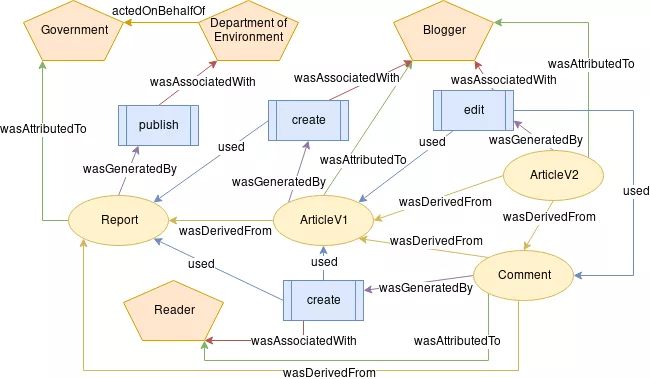
Förderjahr 2017 / Stipendien Call #12 / ProjektID: 2418 / Projekt: Decentralised Data Provenance based on the Blockchain
After introducing provenance and a provenance model in our past blog entries we will present now a simple example scenario and also model it on a high level with W3C PROV.
Let us assume that that the government releases an environmental report. More specifically the department of environment releases the report on behalf of the government as a whole. This report gets picked up by a blogger who reads through it and creates a blog entry based on the report. Now readers of the blog, of course, start commenting and discussing the blog entry and one of the readers realises that there is a factual mistake in the blog article, thus the reader comments the article stating the mistake. The blogger pics up this comment and fixes the mistake, by doing so the blogger creates a new version of the blog article. This, however, is not immediately visible for new readers who find the article. When they read through the article and also the comment stating the mistake they may get confused or lose trust into the factual correctness of the article. To avoid this the blogger provides also a provenance view of his article which can be requested for viewing.

In the figure above we can see this provenance view. To be easier readable all entities (article, report, comment) are depicted in yellow. We have actors (government, department of enviroment, blogger and reader) depicted in orange, and activities of those actors, like creating, editing, publishing, are depicted in blue. The different relations between actors, activities and entities are depicted in different colours based on the relation type to improve readability. We already introduced the different relation types in our previous blog posts. In this figure, we can see a few interesting things. One of them is that the department of the environment acted on behalf of the government in creating the report. This is an important notion when it comes to responsibility. It basically states that the government has some responsibility for the report although it was created by the department of the environment. Which is also easy to reason about. The department of the environment has created the report, it has to make sure the report is factually correct and sound, however, the government as a whole is responsible for the outcome of the report since the government is responsible for taking the according actions to protect the environment. Another interesting thing we can see in this figure is how the blogger used the article in its first version and the comment of the reader to generate a new version of the article. We can easily reproduce which entities were based on which other other entities.
Svetoslav Videnov

My master thesis aims to combine the advantages of the blockchain with data provenance. The blockchain is a distributed ledger which allows persisting data in an unchangeable way. Data provenance is an approach to track what happened to data and by this allowing to build trust into this data.

